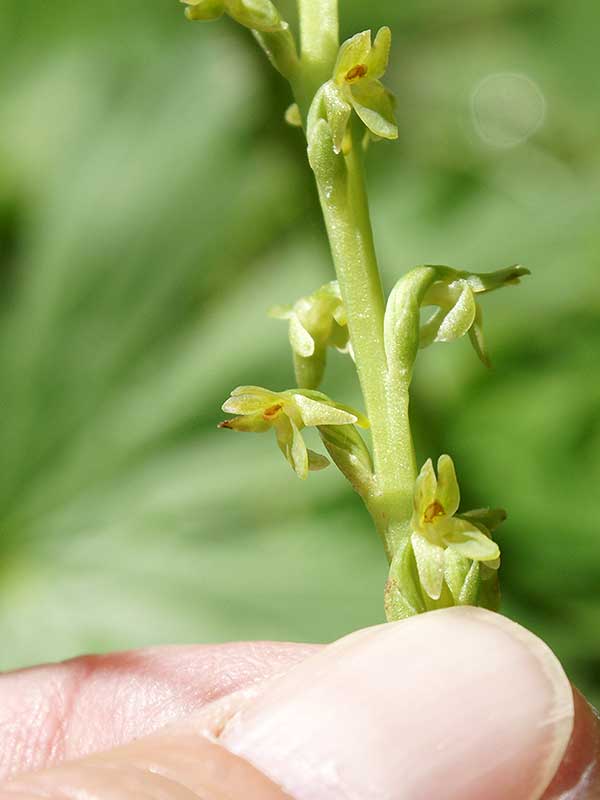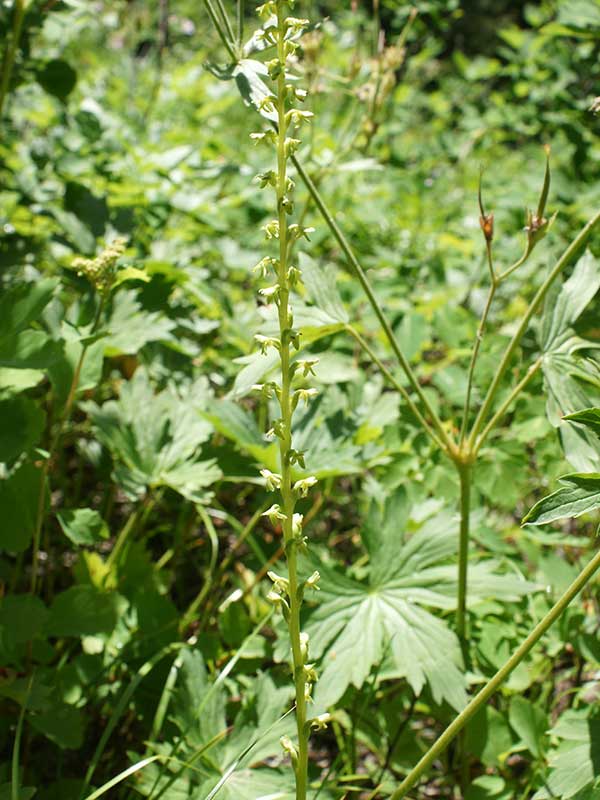Plantanthera unalascensis / slender-spire orchid
- teeny, green flowers, well-separated, not spiraled
- a “tall, thin, green nothing”
- basal leaves prostrate, but not appressed to the ground
- leaves often wither before pollination occurs
- found in many different habitats
Also known as: Alaska piperia, Alaska rein orchid, short-spurred rein orchid
Synonyms: Habenaria unalaschensis, Piperia unalascensis, Platanthera foetida, Spiranthes unalascensis
See also: Platanthera dilatata / white bog orchid; Platanthera huronensis/ green bog orchid
This orchid grows up to about 30″ tall. It sports ca. 6 basal leaves, about 2 x 6 inches, that often wither before flowering begins. It also has stem leaves that are much smaller.
The upper stem of the slender-spire orchid is a spikelike inflorescence. The individual flowers are possibly the smallest flowers of any of our orchids. They are translucent green and widely spaced. This latter point, along with the fact that they don’t spiral, is an important one for distinguishing this from other Platanthera spp. It is said that the flowers are fragrant in the evenings. Given that one of the Latin names is P. foetida, I wouldn’t bank on the fragrance being especially pleasing.
Regarding the individual flowers, the petals are erect and sickle-shaped, but (of course) hard to see. The labellum is blunt with a fleshy central thickening, while the spur is stout and about as long as the labellum. It extends back toward the stem, but doesn’t cross it.
One site has noted how hard it is to photograph, basically because (as another site calls it), it is the “tall, thin, green, nothing.” I guess that’s sort of diagnostic, too.
Despite the “alaska” part of its name, the slender-spire orchid is native to much of western North America and across Canada to the east. In fact, it’s range only reaches to SE Alaska, where it is rare. In the Valley, you might find it in forests, woodlands and scrubland, along roadsides, on outcrops and in thickets, or in meadows. It is often in drier areas. The photos here were taken on the lower half of Tin Cup trail toward the end of July.
Interesting bits – Orchid seeds are the smallest of any plant, barely larger than a speck of dust. Thus, they can be blown far and wide. They also lack endosperm, the nutrient storage tissue found in most seeds. As a result, they can germinate and establish only if helped along by soil fungi. These make it possible for the plants to develop long enough to supply their own nutrients and carbon.
Like other members of the genus, the slender-spire orchid has an obligatory relationship with fungi in the soil. Basically, that means don’t even try to transplant them.
| Color | |
|---|---|
| Family | |
| Blossom size | |
| Inflorescence size | |
| Inflorescence type | |
| When? | |
| Where? |

